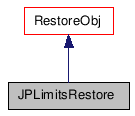#include <interpik.h>
Inheritance diagram for
JPLimitsRestore:

Public Member Functions |
|
| JPLimitsRestore (JointParams *j) | |
| void | Restore (int isUndo) |
| void | Redo () |
| void | EndHold () |
Public Attributes |
|
| JointParams * | jp |
| float | umin [6] |
| float | umax [6] |
| float | uspring [6] |
| float | rmin [6] |
| float | rmax [6] |
| float | rspring [6] |
Constructor & Destructor Documentation
| JPLimitsRestore | ( | JointParams * | j | ) | [inline] |
Member Function Documentation
| void Restore | ( | int | isUndo | ) | [inline, virtual] |
- Remarks:
- The developer implements this method to restore the state of
the database to as it was when theHold.Put() was called with
this restore object.
Regardless of the value of the isUndo parameter, the method must restore the state of the scene to the one it was in when theHold.Put() was called with this restore object.
RestoreObj::Restore and RestoreObj::Redo may be called several times in a row: these methods must protect against any problems that may arise because of this, such as trying to undo multiple times in a row what has been undone already.
- Parameters:
-
isUndo Nonzero if Restore() is being called in response to the Undo command; otherwise zero. If isUndo is nonzero, the developer needs to save whatever data they need to allow the user to redo the operation.
Implements RestoreObj.
| void Redo | ( | ) | [inline, virtual] |
- Remarks:
- This method is called when the user selects the Redo command. The developer should restore the database to the state prior to the last Undo command.
Implements RestoreObj.
| void EndHold | ( | ) | [inline, virtual] |
- Remarks:
- This method is called when theHold.Accept() or theHold.Cancel() is called. This means the restore object is no longer held, it was either tossed out or sent to the undo system. The developer may then call ClearAFlag(A_HELD) to indicate the restore object is no longer being held.
Reimplemented from RestoreObj.
Member Data Documentation
| float umin[6] |
| float umax[6] |
| float uspring[6] |
| float rmin[6] |
| float rmax[6] |
| float rspring[6] |
